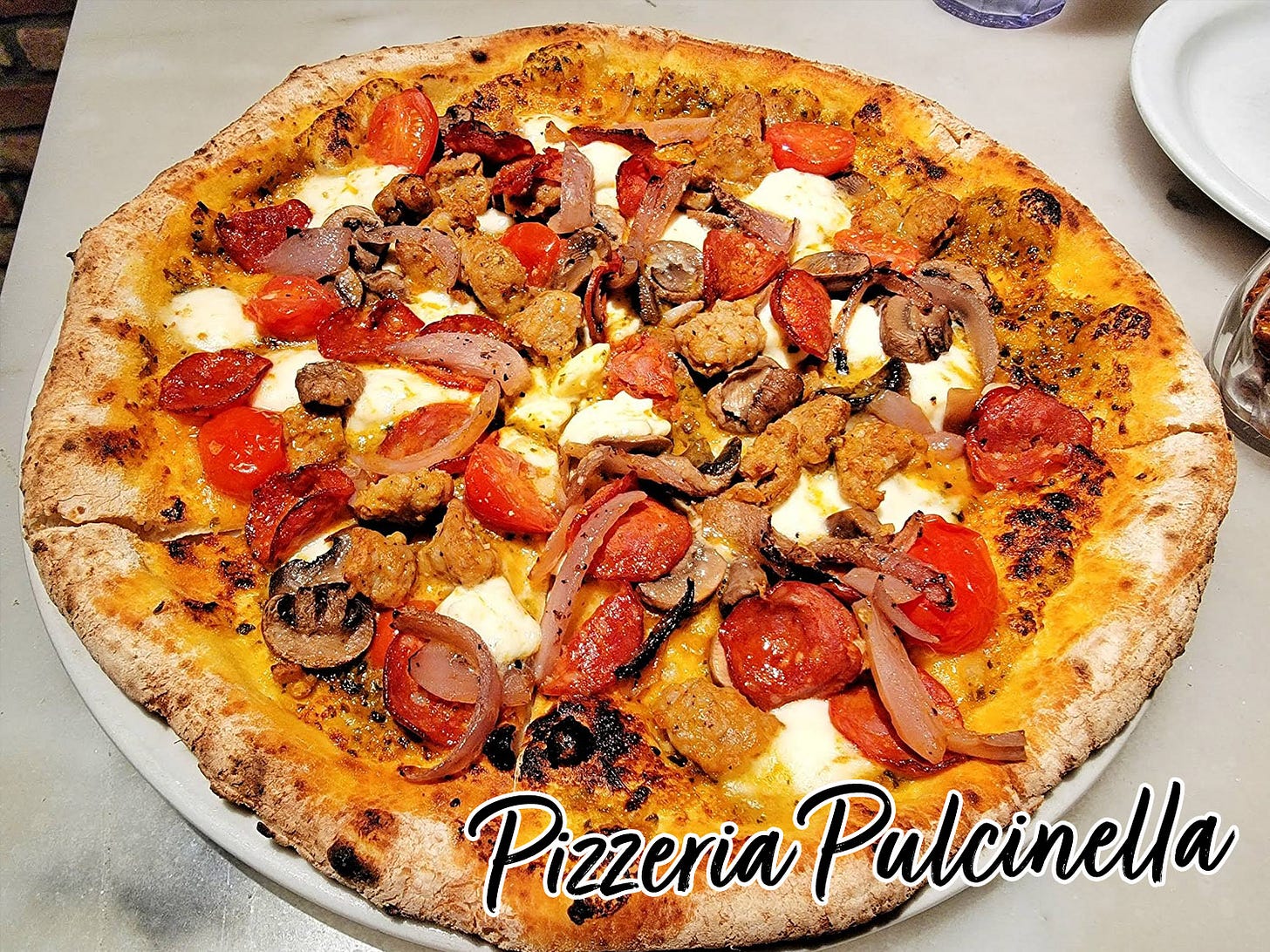On South Seattle’s Pizzeria Pulcinella
Plus: How Filmation went out with a bang with the eighties cartoon, “BraveStarr.”
Right in between South End and Renton, you’ll find an unassuming two-story building housing Pizzeria Pulcinella. It’s one of only six spots in Seattle certified by Associazione Verace Pizza Napoletana, an organization dedicated to safeguarding and promoting the culture of authentic Neapolitan pizza, an EU-designated “Traditional Speciality Guaranteed” dish. In other words, if you don’t see the certification, chances are you’re not getting the authentic thing.
Making a proper Neapolitan pizza is a strenuous process that includes hand-kneading the dough into a crust that measures no more than a ¼ of a centimeter in height. After a 60-90 second wood-fired bake at 905°F, it should be elastic and tender, with an even bite. It’s slightly different from many other types of charred crusts, which often have more of an outer crunch to them. Feel free to read up on the finer points of the Neapolitan pizza – there are a lot of them.
Prestigious certificates are worth very little if the pizza doesn’t actually taste good, but Pulcinella delivers on its promise, no problem. The crust comes out as advertised – and is also very fragrant – with a tomato sauce that, frankly, I could eat by itself with a spoon. (Judge me if you like; I have nothing to prove.) Going with a traditional “Margherita” pie is the purest way to experience the Neapolitan-ness, with just a touch of mozzarella, parmigiano, basil, and olive oil to play off the base flavors. It’s simple in the best of ways.
Branching into less traditional territories isn’t a bad choice, either. The “Santa Lucia” is topped with cream sauce and Yukon Gold potatoes, and is a fully realized pie in its own right. Pair it with the “Margherita” and you will have a good compare-and-contrast meal.
Frankly, you can’t really go wrong at Pulcinella. Be it the spicy “Diavola,” the mushroom-forward “Pozzuoli,” or the hot-honey-based “Piccante,” you’ll be good to go. All the pizzas are excellent. As are the pastas – the cannelloni, a house specialty, is a must-try.
All this to say: You don’t have to eat through the full menu, but then, you probably should. Because it’s all good – certification or no certification.
Find Pizzeria Pulcinella on 10003 Rainier Ave S, and on the web.
In Memory of Jay Olman: How “BraveStarr” Almost Got Away With Murder
Remember the Saturday-morning cartoon, BraveStarr? Unless you’re of “a certain age,” odds are you don’t, but for some, this culturally questionable eighties space western served as a coming-of-age milestone. Mostly because of an episode called “The Price.”

BraveStarr was one of Filmation’s many assembly-line Saturday-morning cartoons, developed as a clandestine advertisement for Mattel action figures. (It served as a follow-up to the more famous He-Man and She-Ra.) The show took place on the planet of New Texas, where we followed Marshal BraveStarr, a Native American portrayed with the type of “sensitivity” only the eighties could allow. Other characters included Thirty/Thirty (think Cringer/Battle Cat from He-Man) and Shaman (basically Sorceress from He-Man – you may spot a pattern here).
The episodes were cut from templates set in earlier Filmation shows, making for lighthearted action comedy. “Skuzz and Fuzz” centers around the marshal’s goofy sidekick, Fuzz (ostensibly Orko from He-Man), discovering that he has an evil cousin named Skuzz. In “Runaway Planet,” BraveStarr blows up a runaway planet to stop it from crashing into New Texas, a plot I’m pretty sure was already used in He-Man. And in “The Price,” a child gets severely addicted to drugs and dies from an overdose.
…
To repeat: In an episode of the Saturday morning cartoon show, BraveStarr, a kid dies from a drug overdose, all in the name of promoting toys for Mattel.

“The Price” is borderline surreal. It features a drug pusher named Dealer (a bit on the nose) who tricks a naïve school-aged kid, Jay, into a life of drugs. The bricks start falling fast as we arrive at the familiar “the first dose is free, but the second will cost ya.” Jay stumbles into crime, threatens his friends not to “squeal,” and tosses out hip lingo like “oh, torch out!” and “that stuff is a real retro-blast!” In the end, he overdoses, and Dealer goes to jail – a tidy 22-minute kids’ cartoon wrapped up with the coda: “Drugs can kill. Don’t mess with them. At best, you live to regret it. And worst, you won’t live.”
I’ll go out on a limb and say that neither Jay nor Dealer got their own action figures, and to this day, I find the ending disturbing.
As for Filmation, BraveStarr was their last gasp. Apparently, making a drug-fueled episode in the tone of Hill Street Blues wasn’t enough to bring the kids in.
If you want to watch “The Price” in its entirety, you can set aside twenty-two depressing minutes to do so, thanks to YouTube.
Finally: Filmation’s Ghostbusters. No, Not THAT Ghostbusters.
If you have ever wondered why the mid-eighties animated Ghostbusters was completely different from the movies, the reason is simple. Sort of. Filmation owned the rights to an obscure 1970s sitcom called Ghostbusters – no relation – which they (out of spite) based a cartoon on after Columbia Pictures decided to make its own movie-based cartoon. The latter ended up being named The Real Ghostbusters, just to make everything as confusing as possible.
The 1980s, what a decade.
Wikipedia: “BraveStarr.” May 3, 2025.
Wikiepedia: “Filmation.“ May 4, 2025.
Fandom: “The Price.”
IMDb: “BraveStarr.“







